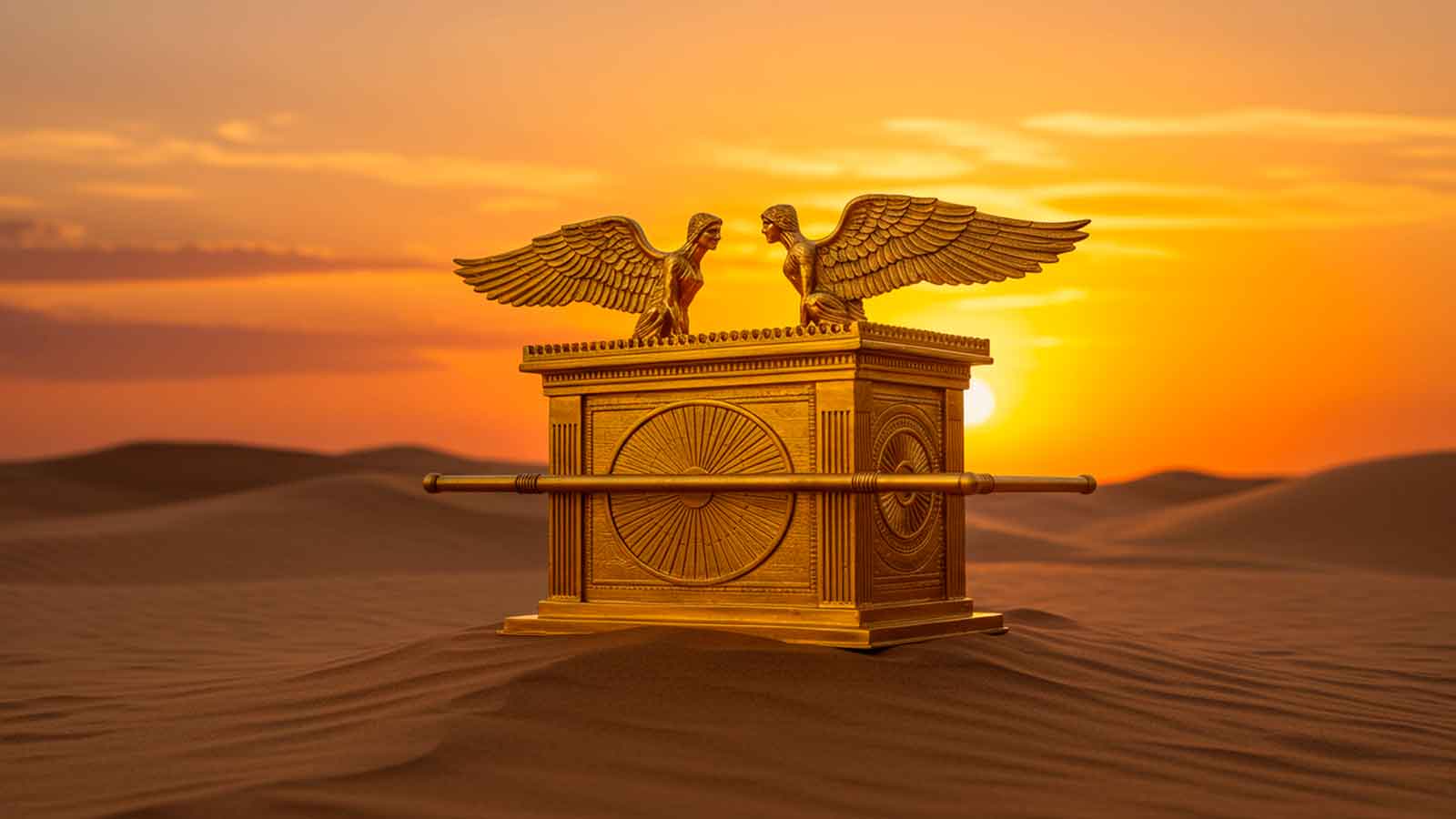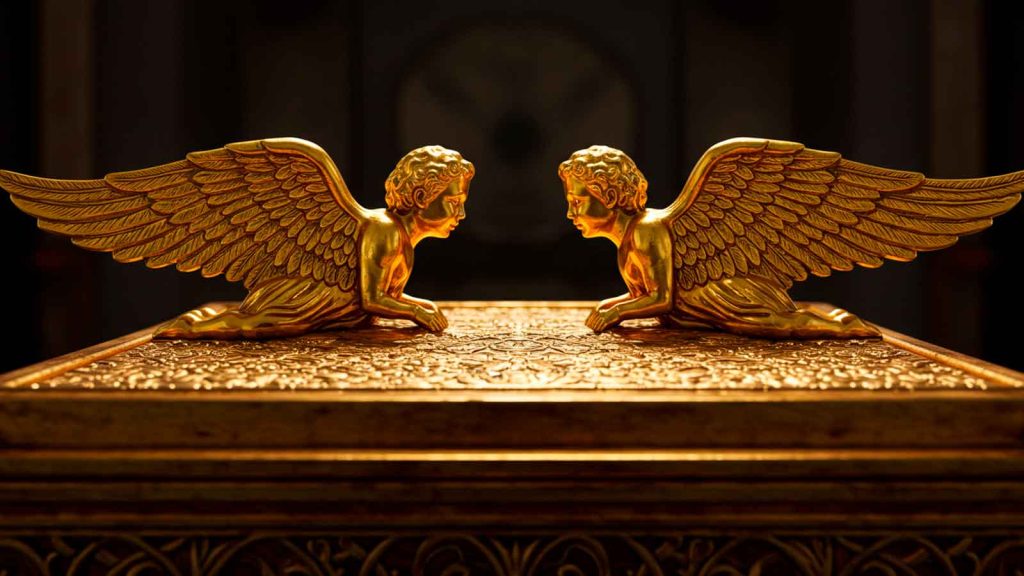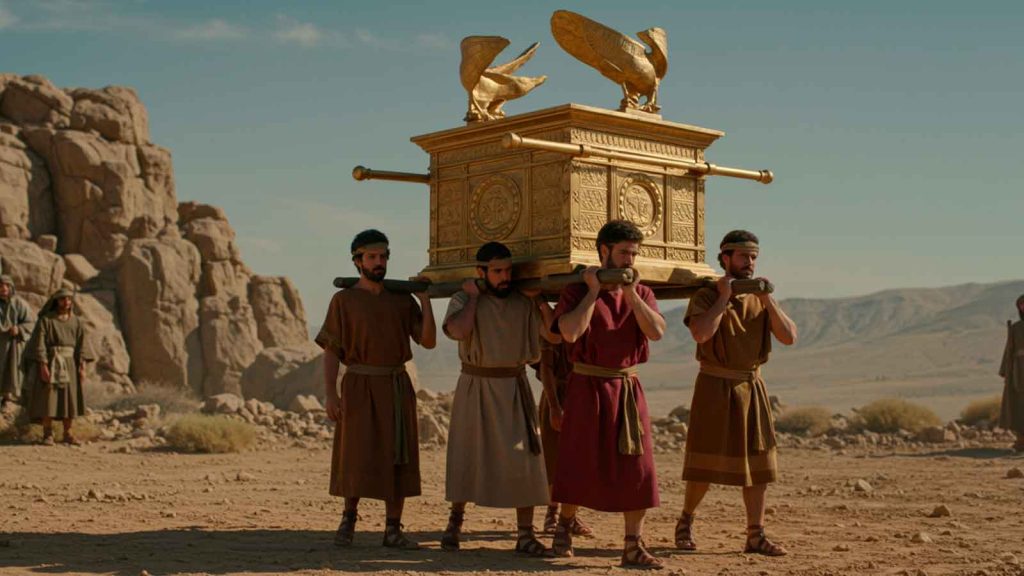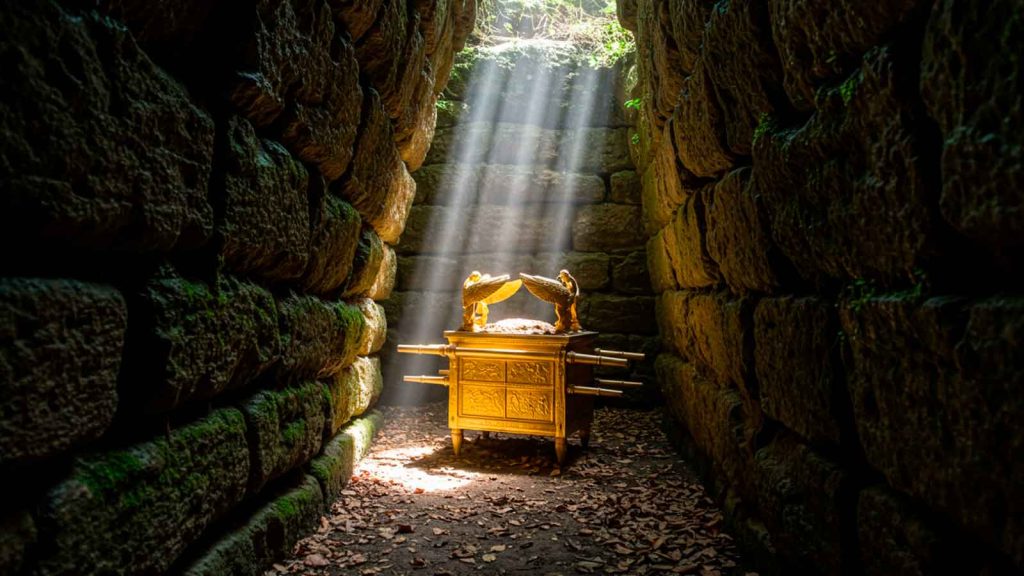The Ark of the Covenant is one of the most enigmatic and fascinating artifacts in the entire Bible. Revered as a symbol of God’s presence among the people of Israel, it carries stories of miracles, warfare, judgment and holiness. Over the centuries, scholars, archaeologists and theologians have tried to unravel its secrets.
In this article, you will learn everything about the Ark of the Covenant: its origin, purpose, appearance, what was inside it, why it disappeared and the main curiosities surrounding this sacred object. Get ready to dive into one of faith’s greatest mysteries.
Table of Contents
What Is the Ark of the Covenant?
The Ark of the Covenant was a sacred chest built at God’s command, following detailed instructions given to Moses on Mount Sinai. It was the most important object in the Tabernacle and later in the Jerusalem Temple, representing the covenant between God and Israel.
The Ark’s Spiritual Function
More than a physical object, the Ark of the Covenant symbolized the presence of God. When Israel walked in fellowship with the Lord, it represented blessing, protection and victory. When the people strayed, the ark might even be removed as a form of judgment.
The Ark and Divine Holiness
The holiness of the Ark of the Covenant was so intense that no one could touch it directly except consecrated priests. Those who disrespected its regulations suffered immediate consequences, such as Uzzah in 2 Samuel 6:6‑7.

Description of the Ark According to the Bible
The most detailed description of the Ark of the Covenant is found in Exodus 25:10‑22, where God commands Moses:
“They shall make an ark of acacia wood—two and a half cubits long, a cubit and a half wide, and a cubit and a half high.”
Converted to modern measurements, the ark was roughly 1.10 m long, 70 cm wide and 70 cm high.
Finishing Details
- Made of acacia wood and overlaid with pure gold inside and out.
- Had four gold rings, one at each corner, through which gold‑covered poles were inserted for carrying.
- Its lid was called the Mercy Seat, also of pure gold, with two cherubim facing each other and their wings spread, representing the divine glory.
The Mercy Seat and God’s Presence
The Mercy Seat was where the high priest sprinkled sacrificial blood once a year on the Day of Atonement (Yom Kippur). It was between the cherubim of the Ark that God spoke with Moses (Exodus 25:22).

What Was Inside the Ark?
The contents of the Ark of the Covenant were highly symbolic. According to Hebrews 9:4, the ark held three items:
The Tablets of the Law
The stone tablets inscribed with the Ten Commandments, written by God’s finger and given to Moses on Sinai, represented the covenant between God and Israel.
The Manna
A golden jar containing manna—the bread from heaven provided in the wilderness—served as testimony of divine provision.
Aaron’s Rod
The rod of Aaron that budded symbolized God’s choice of the Levitical priesthood; the miraculous budding proved the tribe of Levi was set apart for temple service.
Where Was the Ark Built?
The Ark of the Covenant was constructed during Israel’s wilderness journey, soon after leaving Egypt—likely near Mount Sinai, where Moses received direct instructions from God.
The Craftsman Bezalel
According to Exodus 31:1‑5, God chose Bezalel of the tribe of Judah as chief artisan for the ark and all sacred furnishings.
“See, I have chosen Bezalel son of Uri, son of Hur, of the tribe of Judah, and I have filled him with the Spirit of God, with wisdom, understanding and knowledge in all kinds of craftsmanship.”
Bezalel was divinely empowered to work with gold, silver, bronze, wood, precious stones and fine fabrics. He led a skilled team that included Oholiab of the tribe of Dan.
Building the Tabernacle
The Ark of the Covenant is the first item described in God’s instructions (Exodus 25), underscoring its central role in the Tabernacle, the sacred tent where God dwelt among His people.
The entire Tabernacle was erected according to God’s specifications, reflecting heavenly realities (Hebrews 8:5). As the most sacred object, the ark received special attention.
The Importance of Detail Obedience
Every dimension and material for the Ark of the Covenant was precise. Acacia wood resists decay; pure gold symbolizes divine holiness.
Even its transport was prescribed: only the Kohathite Levites could carry it with poles on their shoulders, never touching the ark itself (Numbers 4:15).
A Symbol Built with Excellence
Constructing the Ark of the Covenant was not merely physical—it was an act of obedience, worship and reverence, using the finest materials, the most skilled hands and, above all, direct inspiration from God’s Spirit.
The ark’s construction teaches that God’s work requires zeal, precision and holiness; negligence—such as Uzzah’s unauthorized touch—brought judgment.
Why Was the Ark So Powerful?
The Ark of the Covenant was not just a sacred object; it represented God’s very presence. Its role was defined by the Lord Himself, making it the ultimate symbol of His covenant with Israel.
This direct link to the divine placed the ark at the center of pivotal moments in Israel’s history—evoking awe, respect and undeniable miracles.
The Ark as a Sign of God’s Presence
During wilderness travels and settlement in Canaan, the Ark of the Covenant went before the people, symbolizing that God led them. It preceded them in battles, processions and national transitions.
Yet its presence could not be manipulated. When treated with reverence and faith, the ark brought protection and victory. Used superstitiously, it offered no power—obedience mattered, not the object itself.
When the Ark Guaranteed Victories
One striking example is the fall of Jericho’s walls (Joshua 6): for seven days priests circled the city carrying the ark; on the seventh, the walls collapsed at the trumpet blast and the people’s shout.
Another is the crossing of the Jordan River (Joshua 3): when priests bearing the ark stepped into the water, the river stopped, and Israel crossed on dry ground—echoing the Red Sea miracle.

When the Ark Brought Judgment
In 1 Samuel 4, sinful Israelites tried to use the Ark of the Covenant as magic against the Philistines. Without seeking God, they brought it to battle; disaster followed—Israel lost, Eli’s sons died, the ark was captured.
The episode proved the ark was no talisman—it symbolized covenant relationship. In disobedience, God’s presence withdrew and the ark offered no protection.
Miracles Linked to the Ark
- Jordan River parted: Priests carrying the ark stepped in, waters stopped, confirming Joshua’s leadership.
- Walls of Jericho fell: Obedient faith around the ark toppled fortified walls without weapons.
- Defeat of the god Dagon: Philistines placed the ark in Dagon’s temple; the idol fell twice, shattered (1 Samuel 5).
- Plagues in Philistine territory: Wherever the ark stayed, severe plagues struck until they returned it with guilt offerings.

The Ark’s Disappearance
One of biblical history’s greatest mysteries is the disappearance of the Ark of the Covenant. It was last mentioned before the First Temple’s destruction in 586 BC by the Babylonians.
What Happened to the Ark?
Scripture doesn’t say exactly. Theories include:
- Priests hid it before the invasion.
- It was taken to a safe place, such as Mount Nebo (2 Maccabees 2:4‑8).
- It was destroyed or looted by the Babylonians.
The Ark in Prophecy
Some believe the Ark of the Covenant will reappear in prophetic times, especially when the Third Temple is built.
Curiosities about the Ark
- Original Hebrew name: Aron HaBerit, “chest of the covenant.”
- Stayed 20 years in Abinadab’s house (1 Samuel 7:1‑2).
- Uzzah died touching it improperly (2 Samuel 6:6‑7).
- Obed‑Edom hosted it for three months and was greatly blessed (2 Samuel 6:11).
- Vanished after King Josiah’s reign; absent in the Second Temple.
- The Talmud states it was not in the post‑exile temple.
- Led armies in battle as a sign God marched with Israel.
- Kept in the Holy of Holies, the most sacred space.
- The lid was the Mercy Seat, sprinkled with blood on Yom Kippur.
- Solomon placed it in the Temple; God’s glory filled the house (1 Kings 8:10‑11).
- Carried on poles by Levites; poles were never removed (1 Kings 8:8).
- Some Christians see Mary as a figure of the ark, bearing the “Word of God.”
- Revelation 11:19 shows the ark in heaven in a prophetic vision.
- Ethiopian tradition claims it rests in Axum, in the Church of St Mary of Zion.
Modern Location Theories
Despite its millennia‑long absence, the Ark of the Covenant remains the subject of searches and theories worldwide. No discovery is officially recognized, but some hypotheses stand out.
Mount Nebo Theory
According to 2 Maccabees 2:4‑8, the prophet Jeremiah hid the Ark of the Covenant in a cave on Mount Nebo before Jerusalem’s fall. The site, in modern Jordan, attracts archaeological interest.
Axum, Ethiopia Theory
A popular theory says the Ark of the Covenant was taken to Ethiopia, where it is guarded in the Church of St Mary of Zion in Axum. Guardians claim to protect the true ark, but it has never been examined.
Solomon’s Temple Theory
Another idea suggests the Ark of the Covenant remains hidden in a secret chamber under the Temple Mount in Jerusalem. Excavations are restricted for religious and political reasons.
The Ark in Pop Culture
The Ark of the Covenant has captured modern imagination in film, books and documentaries, blending biblical facts with creative myths.
Indiana Jones and the Raiders of the Lost Ark
The 1981 movie popularized the Ark of the Covenant as a powerful artifact capable of destroying armies. Though fictional, it inspired interest—even among amateur archaeologists.
Documentaries & Alternative Theories
Channels like Discovery, History and YouTube host numerous documentaries on possible ark locations, ranging from Templars to lost civilizations.
The Ark’s Spiritual Symbolism
Beyond history, the Ark of the Covenant carries profound spiritual meaning for Jews and Christians alike.
In Judaism
For Jews, the Ark of the Covenant symbolizes God’s presence and His covenant with Israel. Its absence in the Jerusalem Temple is still felt; its return would signal complete restoration.
In Christianity
Christians consider the Ark of the Covenant a type of Christ. Just as the ark housed the law, manna and Aaron’s rod, Jesus fulfills the Law, is the living bread from heaven, and the eternal High Priest.
Many also reference Revelation 11:19, where the ark appears in heaven as a sign of God’s presence with His people.
What Does the Bible Say about the Ark’s Future?
Jeremiah 3:16 foretells a time when God’s people will no longer remember the ark nor miss it—indicating God’s presence will be so full that no physical symbol is needed.
“In those days, when your numbers have increased greatly in the land,” declares the Lord, “people will no longer say, ‘The ark of the covenant of the Lord.’ It will never enter their minds or be remembered; it will not be missed, nor will another one be made.” (Jeremiah 3:16)
This suggests the Ark of the Covenant fulfilled its temporary role and will be surpassed by the fullness of God’s indwelling presence.
FAQ about the Ark
Does the Ark Still Exist?
No concrete proof exists, but some traditions and theories say it was hidden and will be revealed someday.
Why Can’t Anyone Touch It?
Because it was extremely holy. God’s presence rested upon it, and only consecrated priests with proper rituals could approach.
Was the Ark Used in Battles?
Yes. The Ark of the Covenant accompanied Israel’s armies as a sign of victory when God was with them.
What Do the Cherubim Represent?
The cherubim symbolize God’s glorious presence, positioned over the Mercy Seat, facing the atoning blood.
Will the Ark Ever Be Found?
No definitive answer. Theologically, its purpose may be fulfilled, but for archaeologists it remains one of humanity’s greatest mysteries.
READ ALSO:
- Bible Verses on Healing and Miracles: Strengthen Your Faith
- Blessed Good Night: Spread Faith Before Sleeping
- Proverbs 31:3 – A Wisdom Alert to Protect Your Purpose
- Proverbs 4 Complete with Explanation
FOLLOW US ON FACEBOOK